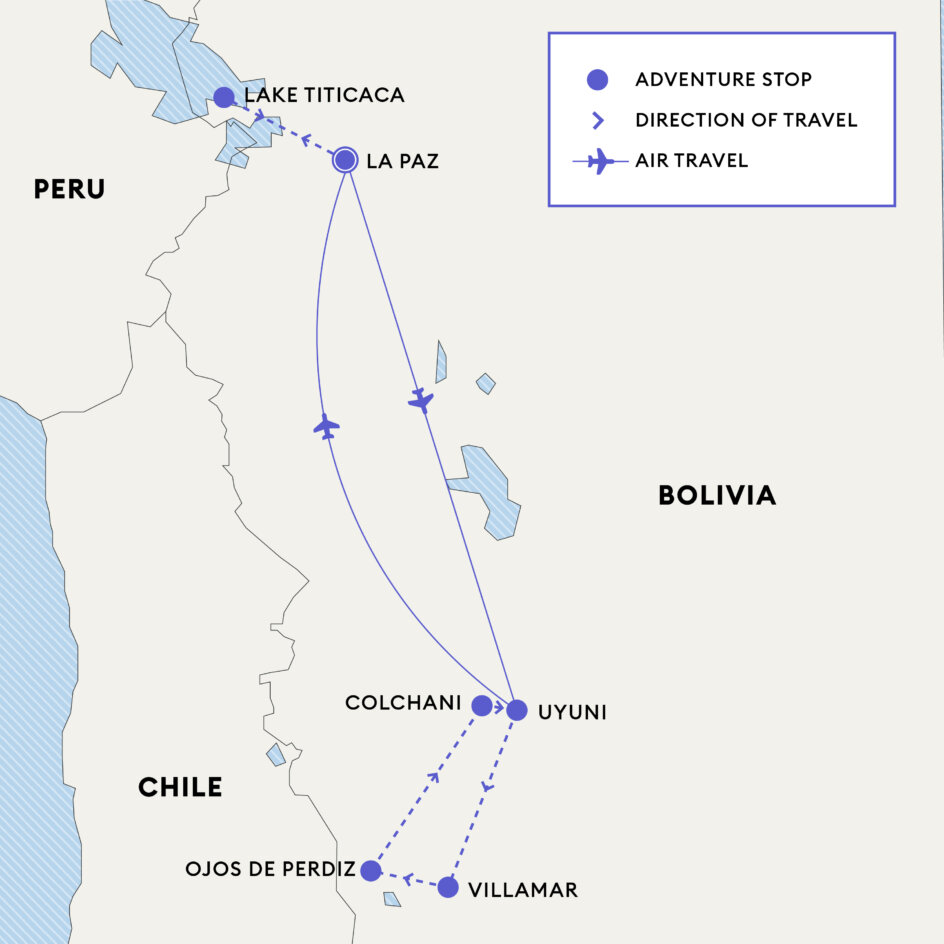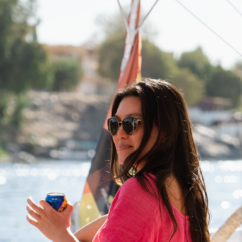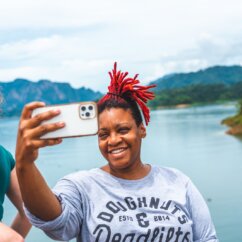-
Which airport do I need to fly in and out of? Plus airport code
Fly into and out of El Alto Airport (LPB) in La Paz.
-
What time should my flight arrive (in time for the welcome meeting)?
Before 3 pm ideally to make it in time for the welcome meeting at 5 pm.
-
What time should my flight depart on the final day?
There are no activities planned for the last day, so you can leave any time you like. Your hotel in La Paz is approximately one hour from El Alto International Airport. Your Pack Leader can help you book transfers the night before if needed.
-
Are airport transfers included?
If you arrive on Day 1 of your adventure, or you’ve booked yourself a pre-night at the same hotel the adventure starts from, your airport arrival transfer will be included. Arrival transfers are private to Flash Pack and in groups depending on flight times, so you may have to wait in the airport for a short while.
However, if you’ve booked alternative pre-trip accommodation or are arriving by another mode of transport, you’ll have to arrange your own arrival transfer.
Please also note: in order to secure your place on the private transfer, you’ll need to provide your flight details to our Customer Experience team no later than 30 days prior to your adventure’s departure date. You’ll get automated email reminders about this, but the team won’t be chasing you. That’s why it’s key to get this information over in good time. If the details are provided later than 30 days pre-departure, you’ll have to arrange your own arrival transfer.
Departure transfers are typically not included due to travellers leaving at varying times. That said, your Pack Leader will happily help arrange departure transfers for you if required.
-
Do I need a visa?
Up-to-date visa and entry information can be found using our official partner, Sherpa, who can help you arrange a visa if needed.
You can also find essential travel advice – including security and local laws, as well as passport and visa information – on the government website of your home country:
Please be aware that passport and visa requirements can change before departure, so it’s important to stay updated with the latest information.
-
What vaccinations and medication will I need?
While we are not medical professionals and cannot offer personalised medical advice, we want to ensure you have a safe and enjoyable adventure. Here are some tips to help you prepare.
1. Consult with a healthcare professional
We recommend scheduling an appointment with your travel nurse or doctor at least eight weeks before your adventure. This will give you ample time to receive any necessary vaccines or medications.
2. Up-to-date medical advice
3. Government travel advice
4. Medication tips
If you take prescription medication, ensure you bring enough to last the entire adventure, plus a few extra days in case of travel delays. Carry a copy of your prescription with you in case you need to visit a clinic while abroad.
We hope this information will help you prepare for a safe and healthy adventure.
-
What standard of accommodation should I expect?
The hotels in the Andean desert and Salar de Uyuni are not the same standard as a large chain hotel, but they are characterful and comfortable – a welcome respite in between long travel days of exploring.
-
What are the drive times like?
You will be spending a considerable amount of time travelling by 4X4 across the Andean Desert and salt flats. The roads in this area are remote and can be bumpy, and you will be covering big distances. However, this is one of the main highlights of the country and there will be scenic stops along the way.
-
What level of fitness do I need for this trip?
On Isla del Sol in Lake Titicaca, you will need to hike one hour up a stone path to your accommodation (there is no other way to get there). We recommend packing a small bag with a couple of days’ worth of clothes for this part of the trip. Alternatively, your bag can be taken up to the eco-lodge by donkey.
We recommend having a read through of the itinerary above, and getting in touch if you have specific questions on fitness.
-
Will I get altitude sickness?
The itinerary has been designed taking into account the altitude but you may still experience altitude sickness, regardless of health or fitness. It’s always worth discussing with a medical professional beforehand in case the altitude can have an affect on any pre-existing health conditions.
-
What's the weather like in the Altiplano region?
The Altiplano region in Bolivia has a high-altitude climate with cold, dry conditions and significant temperature variations. Days can be sunny and warm due to strong sunlight, but nights are very cold, often dropping below freezing, and occasionally reaching as low as -20°C (-4°F) in winter. The dry season, from May to October features clear skies and colder nights, while the rainy season, from November to April, brings more clouds and occasional rain, slightly moderating temperatures. It’s important to pack warm clothing, such as jumpers, jackets and windbreakers, as hotel heating may not fully offset the brisk nighttime cold.
-
What do I need to know about travelling in Bolivia?
We love Bolivia – a land of natural wonders and vibrant culture. However, please be aware that the infrastructure is basic. This means that traffic, delays, strikes can happen on your adventure at any time. The hotels are basic and some normal everyday luxuries such as WiFi or hot water cannot always be provided and power shortages can be fairly common (even in upgraded hotels and private homes). During the winter (from June to August) the water freezes in the pipes, and it can take several minutes to run through.
This is a true back-to-basics adventure destination. We appreciate your patience and understanding that these occurrences are outside of our control.
-
Will this itinerary change?
Please be aware that the itinerary, activities, and hotels are subject to change. These changes are rare but can happen with little notice due to availability, poor weather, seasonal changes, or other circumstances beyond our control – but we’ll always do our best to ensure it has little impact on your experience.
In the rainy season (from the end of November to the end of April) the Altiplano becomes difficult to cross because the roads are not paved. On the other hand, the Salar de Uyuni fills with water, turning into a large lake, although the view is very beautiful. It can be difficult to reach Tahua and Isla Incahuasi, so the program is subject to change depending on current conditions.
From time to time, we may also make changes to your itinerary to try out new ideas and keep things fresh and exciting which we will always try and communicate to you.








